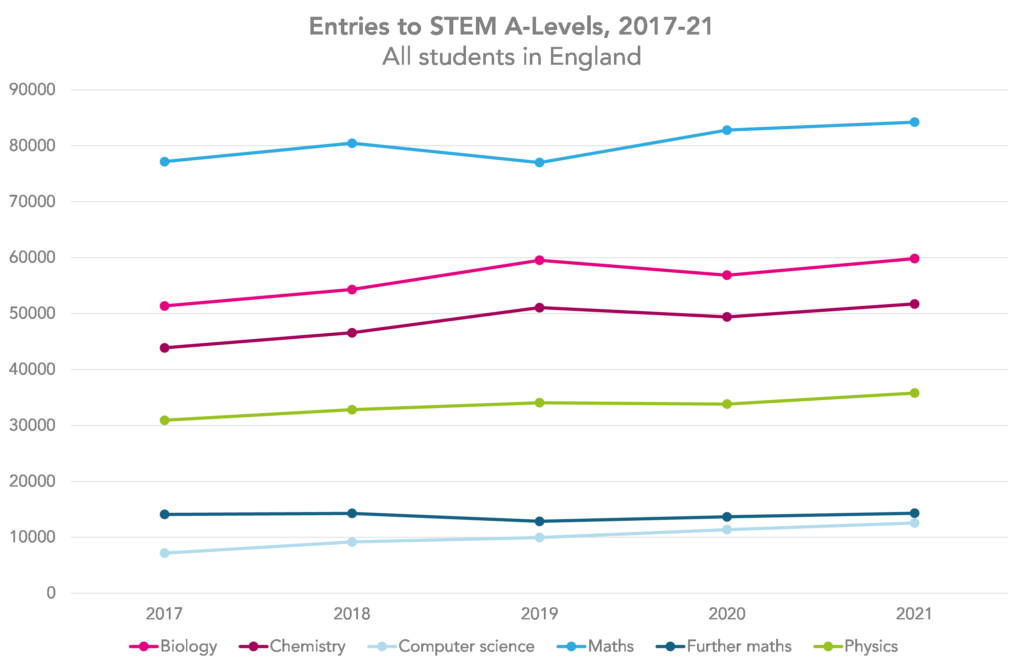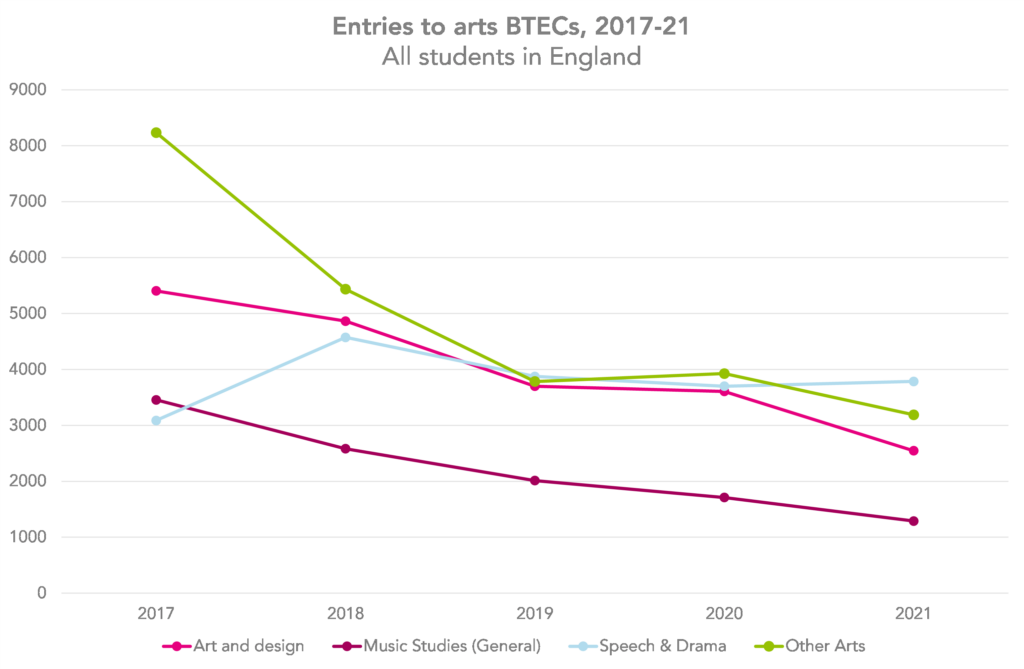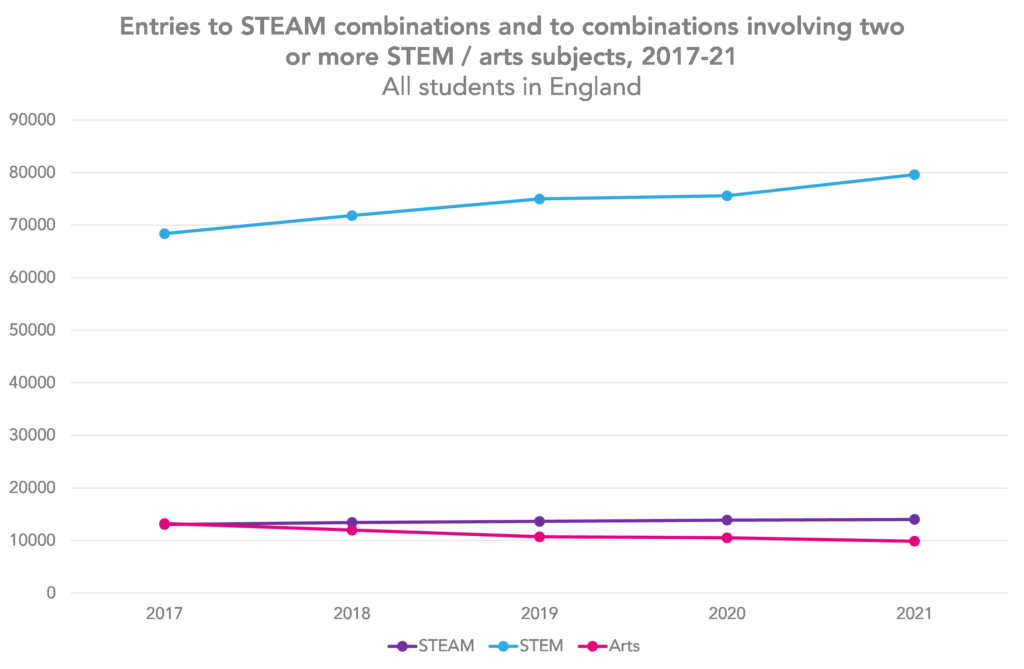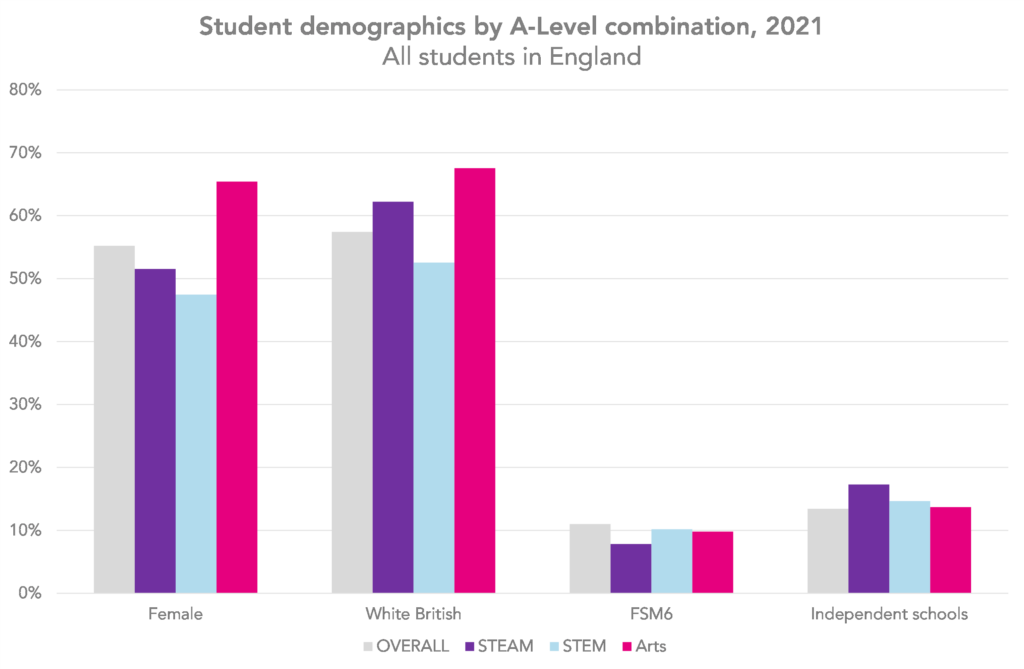Keeping up with the acronyms is always a challenge in education. First we had STEM (science, technology, engineering and maths), then we had STEMM (science, technology, engineering, maths and medicine) and now we have STEAM (the STEM subjects, plus the arts).
There’s been a fair amount of research into integrating the sciences and the arts in education – and beyond – in recent years. But when they’re given a choice, are students likely to opt for a STEAM combination of subjects? And is the popularity of STEAM on the rise?
In this post, I’ll try to answer these questions by looking at the subjects studied by Key Stage 5 students from 2017-21, using data from the National Pupil Database. Unfortunately data for 2022 isn’t available for research just yet.
Trends in STEM and arts entries
We’ll start with a look at trends in entries to STEM subjects and arts subjects separately.


Entries to STEM subjects at A-Level have increased over the last five years, while entries to most arts subjects have fallen.
Broadly speaking, STEM subjects are more popular than arts subjects. But the most popular arts subject, art and design, has more entries than STEM subjects such as physics and computer science, and had a boost in entries in 2021.[1]
Now let’s take a look at BTECs.[2] In the charts below, we show the total number of entries to any Level 3 BTEC in the relevant subject, including awards, certificates and diplomas.


As at A-Level, entries to arts subjects have broadly declined, and arts subjects are less popular than STEM subjects. With the exception of computer appreciation / introduction, entries to STEM subjects have remained fairly stable over the last few years.
Some of the falls in entries year are likely linked to qualifications that are no longer counted in performance tables.
T-Levels are as yet still too recent a development for trends to be visible.
Which combinations?
Before we look at trends in STEAM entries, it’s worth a pause to look at the combinations students are selecting. We’ll start with A-Levels.

For every year from 2017-21, the most popular STEAM combination of A-Levels has been design and technology, maths and physics, with art and design, maths and physics in second place. Other popular combinations include art and design, biology and psychology, and art and design, biology and chemistry.
But we should note that even the most popular STEAM combinations are actually relatively unpopular. The number one STEAM combination – D&T, maths and physics – had 1,266 entries in 2021, while the most popular overall combination – biology, chemistry and maths – had 14,095.
When we bring in BTECs, things get a little more complicated. Many students study a single BTEC, but some of these, such as music technology, could be said to be STEAM subjects in themselves.
For those students who do study more than one BTEC, STEAM combinations are unusual – the most popular (Applied Sciences, Speech & Drama) had just 16 entries in 2021.
BTEC / A-Level in a STEAM combination of subjects are more common, with more than 300 students taking the most popular combination (BTEC Applied sciences, A-Level art and design) in 2021. But again, entries to even the most popular STEAM combinations pale in comparison to entries to the overall most popular combination (BTEC Health Studies, A-Level psychology, A-Level sociology), which had 1,194 entries in 2021.
With the advent of T-Levels, we can perhaps expect STEAM combinations in vocational KS5 qualifications to become rarer.
The rise of STEAM
So has there been an increase in entries to STEAM subject combinations?

There does indeed appear to have been an increase in STEAM A-Level entries over the last five years. This is particularly interesting in the light of the general decline in entries to arts subjects at A-Level.
STEAM combinations involving BTEC, or a mixture of BTECs and A-Levels, are much less common and have remained flat over the last three years.
The rise in STEAM entries has coincided with an increase in entries to STEM subjects. So it may be the case that as STEM entries have increased, they have come to include a broader range of students, including more who are interested in both STEM and the arts.
On the other hand, it may be that STEM and / or arts students are more open to STEAM combinations than they were in the past.
Over the same period, there has also been an increase in the number of students studying more than one STEM subject, and a decrease in the number studying more than one arts subject.

But entries to both STEAM combinations and combinations involving two or more arts subjects were much lower than entries to combinations involving two or more STEM subjects.
Let’s take a look at the demographics of the students studying a STEAM combination of A-Levels.

STEM students are less likely to be female and less likely to be white British than A-Level students overall, while the opposite is true of arts students. STEAM students are somewhere between the two.
Both STEM and arts students are slightly less likely to have been eligible for free school meals in the last six years than A-Level students overall, and slightly more likely to have attended an independent school. STEAM students are even less likely to be disadvantaged and more likely to have attended an independent school.
Summing up
STEAM A-Level combinations have become somewhat more popular over the last few years, but they are still much less popular than all-STEM or all-arts combinations.
Perhaps if the system allowed students to study a broader range of subjects at Key Stage 5, we’d see more STEAM combinations.
[1]: ‘Art and design’ here includes: ‘Art & Design’, ‘Art & Design (3d Studies)’, ‘Art & Design (Critical Studies)’, ‘Art & Design (Fine Art)’, ‘Art & Design (Graphics)’, ‘Art & Design (Photography)’ and ‘Art & Design (Textiles)’.
[2]: ‘Other sciences’ and ‘other arts’ includes all subjects with less than 1000 entries in 2021.







Your last sentence sums it all up in my opinion: “Perhaps if the system allowed students to study a broader range of subjects at Key Stage 5, we’d see more STEAM combinations.”
I work encouraging more female students to continue studying maths post -16. One barrier is that females are more likely to study maths with non- STEM subjects (than males) and those choices are not often possible in terms of a schools timetabling. Also, as girls tend to perform better at GCSE across the board, another issue is that of being an all-rounder. They have a number of viable subjects to choose from but can only pick 3.
Hi Rachel, thanks for bringing this up. I definitely agree and I think the same is true of other STEM subjects. It also seems to be fairly common for students taking a science A-Level to be required to study another science subject or maths alongside it – which can be even more off-putting if there are other subjects you’re also interested in.
I think the author has fundamentally misunderstood that D&T is a STEM subject not an arts subject.
Hi Jason. Thanks for your comment, and I take your point about D&T. I’m not entirely convinced that it should be classed as a STEM subject, but I do think it’s debatable whether it should be defined as an arts subject. Perhaps you could argue that it’s a STEAM subject in itself, with elements of both art (or certainly design) and STEM. We followed the approach of previous research (eg this from the Cultural Learning Alliance) in defining it as an arts subject here.